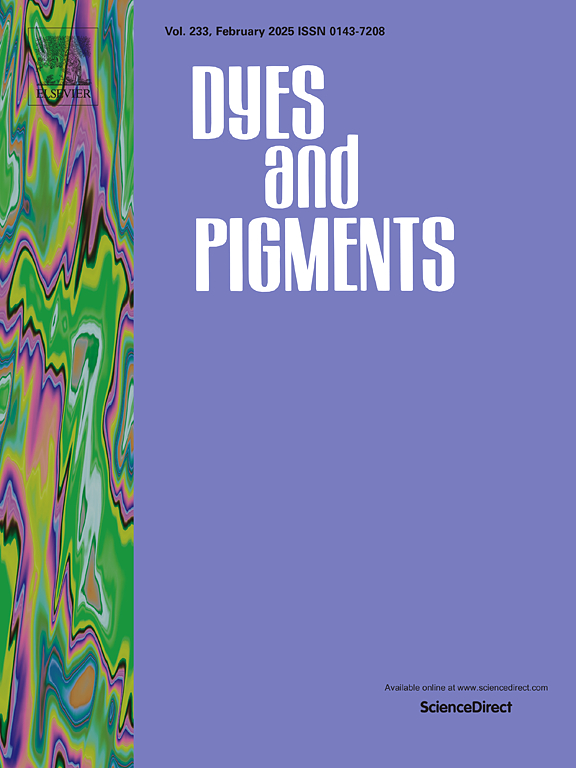Heteroleptic red iridium(III) complexes with donor containing main ligands and dithionate ancillary ligand
IF 4.1
3区 工程技术
Q2 CHEMISTRY, APPLIED
引用次数: 0
Abstract
Three heteroleptic cyclometalated iridium(III) complexes, namely (dpapiq)2Ir(dipdtc), (dpapqz)2Ir(dipdtc) and (qzpcz)2Ir(dipdtc), with the sulfur-containing ancillary ligand N,N-diisopropyldithiocarbamate (dipdtc) were synthesized at 60 °C due to the strong coordination ability between S and Ir atoms. All molecular structures were confirmed by the single crystal characterization. The introduction of electron donors with large steric as triphenylamine or 9-phenyl-9H-carbazole into the isoquinoline and quinazoline as the main ligands in the Ir(III) complexes can tune the photophysical properties, thus improving the luminous efficiency and affect the corresponding organic light-emitting diode (OLED) performance. (dpapiq)2Ir(dipdtc), (dpapqz)2Ir(dipdtc) and (qzpcz)2Ir(dipdtc) complexes show red emissions peaking at 629, 631 and 631 nm with photoluminescence efficiencies around 60 % and phosphorescence lifetimes in the range from 0.63 to 2.04 μs, respectively. Complex (dpapiq)2Ir(dipdtc) was selected as the dopant in the OLED, which exhibits stable electroluminescence peaking at 629 nm with Commission Internationale de L'Eclairage coordinates of (0.68, 0.31) and a narrow full-width at half-maximum of 44 nm. Furthermore, the device also possesses moderate performances with a maximum external quantum efficiency of 14.5 %.

含主配体和二硫代辅助配体的异电性红铱(III)配合物
利用S原子与Ir原子之间较强的配位能力,在60℃下合成了3种杂电性环金属化铱(III)配合物(dpapiq)2Ir(dipdtc)、(dpapqz)2Ir(dipdtc)和(qzpcz)2Ir(dipdtc),并配以含硫配体N,N-二异丙基二硫代氨基甲酸酯(dipdtc)。所有分子结构均通过单晶表征得到证实。在Ir(III)配合物中以异喹啉和喹唑啉为主要配体,引入三苯胺或9-苯基- 9h -咔唑等具有大空间位的电子给体,可以调节其光物理性质,从而提高发光效率,影响相应的有机发光二极管(OLED)性能。(dpapiq)2Ir(dipdtc)、(dpapqz)2Ir(dipdtc)和(qzpcz)2Ir(dipdtc)配合物在629、631和631 nm处发光,发光效率约为60%,磷光寿命范围为0.63 ~ 2.04 μs。选择配合物(dpapiq)2Ir(dipdtc)作为OLED的掺杂剂,在629 nm处表现出稳定的电致发光峰,国际发光委员会坐标为(0.68,0.31),半峰宽窄为44 nm。此外,该器件还具有中等的性能,最大外量子效率为14.5%。
本文章由计算机程序翻译,如有差异,请以英文原文为准。
求助全文
约1分钟内获得全文
求助全文
来源期刊

Dyes and Pigments
工程技术-材料科学:纺织
CiteScore
8.20
自引率
13.30%
发文量
933
审稿时长
33 days
期刊介绍:
Dyes and Pigments covers the scientific and technical aspects of the chemistry and physics of dyes, pigments and their intermediates. Emphasis is placed on the properties of the colouring matters themselves rather than on their applications or the system in which they may be applied.
Thus the journal accepts research and review papers on the synthesis of dyes, pigments and intermediates, their physical or chemical properties, e.g. spectroscopic, surface, solution or solid state characteristics, the physical aspects of their preparation, e.g. precipitation, nucleation and growth, crystal formation, liquid crystalline characteristics, their photochemical, ecological or biological properties and the relationship between colour and chemical constitution. However, papers are considered which deal with the more fundamental aspects of colourant application and of the interactions of colourants with substrates or media.
The journal will interest a wide variety of workers in a range of disciplines whose work involves dyes, pigments and their intermediates, and provides a platform for investigators with common interests but diverse fields of activity such as cosmetics, reprographics, dye and pigment synthesis, medical research, polymers, etc.
 求助内容:
求助内容: 应助结果提醒方式:
应助结果提醒方式:


